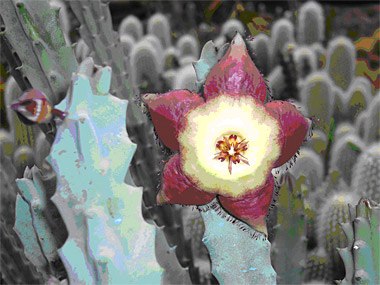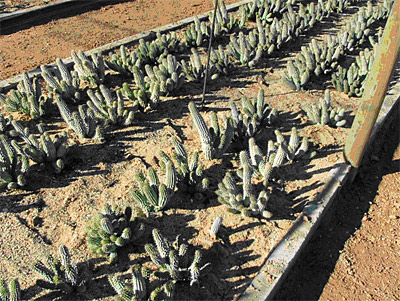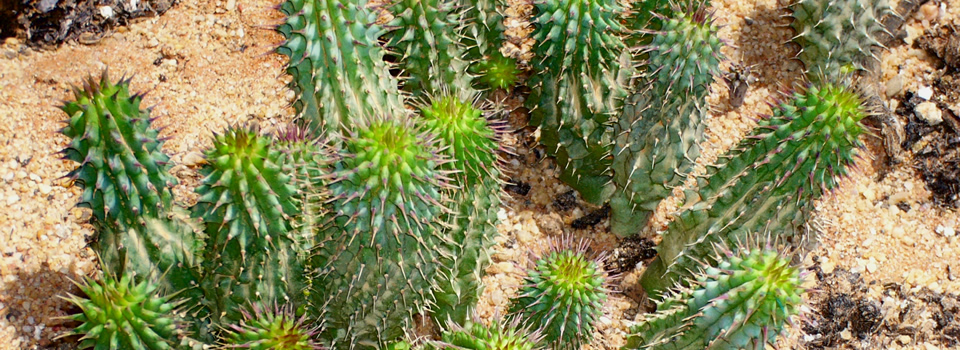Hoodia gordonii is a succulent South African plant– other than often stated it is not a cactus. Hoodia is a protected plant: it is listed in the Annex II of the Washington Convention. However, the list is wrong regarding the family: Hoodia is not an Apocynacea, as indicated in Annex II, but in fact an Asclepiadacea.
The status as a protected plant now requires not only an export CITES certificate, but also import permission to third countries under any form – plant material, extracts or isolates. Hoodia is by now required to originate from cultivation. Despite these very strict conditions, clandestine wild crafting is still practiced, thus endangering the natural habitats of Hoodia.
The transfer to cultivation is possible, however, it has some pitfalls. Frequently a more or less complete lack of active constituents is observed when Hoodia is cultivated without respecting the proper techniques.
Uses
Hoodia gordonii is a relatively recent “discovery”: Although it is said to have been used to stop hunger and as a source of water during the treks of the Boers in South Africa, the attention on Hoodia was triggered by the discovery of a fraction of triterpenic glycosides with hunger suppressing effects. This finding led to a patent on potential drugs derived from the triterpenic compounds mostly known under the name of “P57”. The patent excludes the use of extracts or synthetic derivatives of P57, but of course does not cover herbal powder preparations. Correspondingly many Hoodia products containing Hoodia plant powders are advertised as weight loss products.
The anti-appetite effects of Hoodia gordonii have been confirmed in pharmacologic experiments. Clinical trials have not been published, however, according to reports and traditional experience the effect is real. Pharmacology points to an appetite-suppressing effect directly on the level of the CNS.
Safety
Safety does not seem to be an issue in the dosages usually used in Hoodia products. There are as yet no publications using established methods of toxicological research, however, the long-dating experience with the plant and the high and safe consume as an appetite-suppressant especially in the United States has to be taken into account. The usual dose in supplements is 25-250 mg/dose of the dry powder. No clinical toxicity has been reported to date with such quantities. According to press reports GRAS-status (Generally recognized as safe) has been applied for in the United States.
Adulterations
Due to over-harvesting Hoodia is on the verge of extinction. It is on the CITES list of protected plants, but still illegal and destructive collections take place. Correspondingly, mislabelling and many adulterations have been detected. A typical adulteration seems to be cactus powder, fibres from Opuntia ficus-indica, or otherwise powders from related and more abundant species not necessarily containing the fraction of triterpenic glycosides.
Since the Republic of South Africa officially requires cultivated material for exports, another type of quality problem emerged. The anti-appetite effect of Hoodia is related to its contents in triterpenoid saponins, but under the conditions of cultivation these triterpenes are frequently absent. This creates a new form of adulterations: Preparations manufactured from such material do contain Hoodia, but will probably not have an effect on body weight.
Activities in Hoodia
The current phytochemical knowledge is that the fraction of triterpenes in Hoodia gordonii contains at least 20 related glycosides called – according to the publication – either gordonosides or hoodigosides. In fact, the same type of constituents was known under the name of boucerins and stavarosides before their detection in Hoodia gordonii, which adds to the confusion.
We are currently supporting an investigation into the phytochemical composition of various Hoodia species and related genera. This investigation already demonstrated the presence of closely related constituents in other species of the Asclepiadaceae.
Figure: Tromotriche revoluta HAW. (Asclepiadaceae), one of the related species of Hoodia currently under phytochemical investigation
In parallel to the screening we have established a cultivation of Hoodia gordonii in South Africa, taking into account the WHO rules of Good Agricultural and Collection Practise (GACP), and the principles of organic cultivation. The fields qualify for biocertification (no use of pesticides or herbicides, no contaminations with heavy metals).
Figure: MAP Hoodia cultivation in South Africa
Next to the optimization of biomass we have focused on the impact of cultivation parameters on the content of triterpenes as the supposedly active fraction.
Oral presentations
Hoodia gordonii: Neue „Wunderdroge“ oder rationales Phytotherapeutikum? GCRN-Symposium: Sekundäre Pflanzeninhaltstoffe und Pflanzenextrakte in der Diabetestherapie”, Munich (Germany), 9. March 2005.

